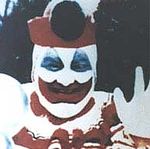
Walking fast, you round the corner of an urban street and collide with — a clown — the greasepaint, the red, bulbous nose, oversized shoes, fright wig, exaggerated clothing, exaggerated smile, exaggerated eyes. Immediately you feel nausea, your hands sweat, you struggle to breathe, you feel panic, anxiety and dread. Your mouth goes dry and your heartbeat races. Your emotions are in turmoil. The clown is only advertising a new restaurant, but that makes no difference to you. You race in the other direction and go several blocks out of your way to avoid… the clown. If the above describes you, then you may have coulrophobia, literally ‘fear of someone walking on stilts.’
If you find the foregoing inherently hilarious, then you probably do not have coulrophobia.
Coulrophobia sufferers, you’re not alone. According to one study, 7.8% of Americans are afraid of clowns. Only 10.2% are afraid of zombies, so that’s saying something.
But why? Perhaps it’s Sigmund Freud’s concept of the ‘uncanny’ – something that is both familiar and unfamiliar. The clown looks, well, kind of like a human being, but the eyes, mouth, feet, costume and hair are all profoundly wrong and in disquieting ways. The disconnect between the human expressions and social cues that we’ve learned to decipher and the clown’s painted face means that we can’t trust ourselves to decipher what we see.
We simply can’t tell what the clown is thinking or feeling. How about Pogo the Clown above – what’s he thinking in this photo? Which brings us, of course, to inventors. Inventors have been dealing with clowns for years, and in remarkably violent ways. How about U.S. Patent 1,003,588 issued September 19, 1911, for a target shaped like a clown face. You shoot the clown in the eye and his lights go out. I, for one, feel better just thinking of it.

Or how about U.S. Patent 420,995 issued February 11, 1890 for a ‘Beheading Block and Ax’ for simulating cutting the head off of a clown. It’s just as creepy as it sounds. Clearly these inventors had some issues to work through.

By the way, real-life nightmare Pogo the Clown murdered 33 people in his home near Chicago in the 1970s and stuffed 29 bodies under the house. The rest went in the river. Pogo’s house was razed and a new house was built on the site. It’s for sale now. Here’s your chance to own a piece of history.
And you don’t have to worry about Pogo. He got the needle in 1994. We’re almost pretty sure that he’s really dead. Pretty sure. Happy Halloween!
— Robert Yarbrough, Esq.

